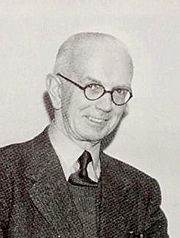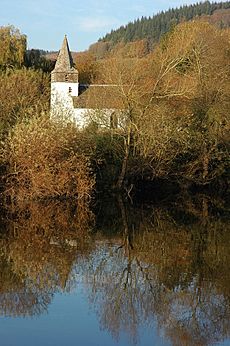Fred Hando facts for kids
Quick facts for kids
Fred Hando
|
|
|---|---|
 |
|
| Born |
Frederick James Hando
23 March 1888 Maindee, Newport, Monmouthshire, UK
|
| Died | 17 February 1970 (aged 81) St. Joseph's Nursing Home, Newport, Monmouthshire
|
| Nationality | British |
| Occupation |
|
| Known for | Publications on history of Monmouthshire |
| Children |
|
Frederick James Hando MBE (born March 23, 1888 – died February 17, 1970) was a famous Welsh writer, artist, and schoolteacher. He came from Newport, a city in Wales.
Fred Hando loved to write about the history, special character, and old stories (folklore) of Monmouthshire. He also called this area Gwent. He wrote nearly 800 newspaper articles and several books. These were published from the 1920s to the 1960s.
Contents
About Fred Hando's Life
Early Life and Education
Fred Hando was born in Maindee, Newport. His father, Alfred, was a postmaster. Fred went to school in Newport. He had two younger brothers, Frank and Harry.
He later trained to be a teacher at Borough Road College in London. After his training, he came back to Newport to teach.
Military Service and Family Life
During the First World War, Hando served as an officer in the Royal Engineers. He was a gunnery officer, meaning he was in charge of cannons and artillery. His time fighting in Flanders (part of Belgium) deeply affected him.
Hando married Alice Stanton. They had two children, Margaret and John. Sadly, Alice passed away when she was young. Later, Hando married Daisy, who worked at his school. They had a son named Robert.
A Special Headmaster
In 1925, Fred Hando became the first headmaster of Hatherleigh School in Newport. One of his students there was Johnny Morris, who later became a well-known radio and TV presenter.
Hando believed in an open and modern way of teaching. A former teacher at the school, Miriam Andrews, said he was "a wonderful headmaster." She also said he made the children very proud of their school.
Writing and Local History
Hando became very interested in local history. He was asked to draw pictures for a big book series about Monmouthshire by Sir Joseph Bradney.
His first articles about Monmouthshire were printed in the South Wales Argus newspaper in 1922. The editor, William Collins, agreed to publish 15 articles at first. In total, Hando wrote 795 articles for the newspaper. His last article appeared just a few days before he died in 1970. People loved reading his articles so much that the newspaper page where they appeared became very popular for advertisements. Many of his articles and drawings were later put together into books.
In his early writings, Hando was very interested in ley lines. These are imaginary straight lines that connect ancient places like stone circles. He believed studying these lines could help understand history from before Roman Britain.
Awards and Later Years
Fred Hando was also the organist and choirmaster at Summerhill Baptist Church in Newport for many years.
In 1953, he received the MBE award. This award was given to him for his great work in education and for his contributions to Monmouthshire.
Hando passed away on February 17, 1970, at the age of 81. He died at St. Joseph's Nursing Home in Newport.
Fred Hando's Writings and Art

Fred Hando's main goal in writing his articles was to encourage people to explore the "little places of a shy county." He wrote this in his 1944 book, The Pleasant Land of Gwent.
He didn't focus on famous places like Raglan Castle or Tintern Abbey. Instead, he wrote about less known spots. These included the "Virtuous Well" at Trellech, the "tallest house in Monmouthshire" at Treowen, and an old marker at Croes Llwyd.
His writings covered more than just buildings. Edwin Morris, who was the Archbishop of Wales, described Hando's work. He said it included memories, old stories, local history, place names, and stories about interesting people. All of this was shown with Hando's beautiful drawings.
Caring for History and Nature
Hando was also interested in protecting old places and nature. This is called conservation. In 1951, he wrote about Allt-y-Bela, an old house that was falling apart. He said, "unless immediate and drastic action is taken, we shall lose priceless relics." Fifty years later, the house was still in bad shape.
He also cared about the wider landscape of Monmouthshire. In 1954, he wrote an article called "The Threat to Machen Vale." In it, he spoke against plans to build an electricity generating station in the beautiful Vale.
Folklore and Local Customs
Hando was very interested in the old stories and customs of Monmouthshire that were disappearing. He wrote about the Mari Lwyd, which is a horse's skull covered with a sheet. This was part of Christmas celebrations in the county.
He also wrote about the legends of Jack o' Kent. One story says Jack caused a big crack in The Skirrid mountain. He supposedly jumped to it from the Sugar Loaf, which is about four miles away!
Local Pubs and Travel Guides
Monmouthshire's pubs (local inns) were another topic Hando loved. He wrote about many of them, and the Robin Hood Inn, Monmouth was one of his favorites. In his Monmouth Town Sketch Book, he remembered visiting in 1947. There, he met some of the last "Monmouth 'cards'" – local characters.
Hando's Pictorial Guide to the Wye Valley and the Forest of Dean was different from his other books. It was a regular travel guide, not just a collection of his articles.
Fred Hando's Lasting Impact
After Fred Hando passed away, the Monmouthshire Local History Council created several "Hando seats." These were special benches placed at beautiful viewpoints in the county that Hando loved. People donated money to fund these seats.
The seats were placed in places like Dixton churchyard, at Llandegfedd Reservoir, on Lawrence Hill in Newport, at the top of the Wyndcliff near St. Arvans, and near Keeper's Pond on the Blorenge mountain near Blaenavon.
Even nearly 50 years after his death, Hando and his work are still remembered. His detailed writings about the county's history were mentioned in discussions about building a new M4 motorway extension across the Gwent Levels. Also, Paul Flynn, a former Member of Parliament for Newport West, remembered Hando's newspaper columns when talking about journalism.
Since November 2017, the South Wales Argus newspaper has been re-publishing his weekly "Rambles in Gwent" column. This gives new readers a chance to enjoy his writings. The editor, Kenneth Loveland, said Hando's work captured "The shy beauty of this delectable county."
Fred Hando's Family
Fred Hando's daughter, Margaret, was born in April 1916. She studied at St Anne's College, Oxford. In 1939, she married Charles Smith.
Her husband became a Labour MP (a person elected to make laws) in 1945. He later became a Government minister and was given a special title (ennobled) in 1967. Margaret was also a councillor (a local government official) and a Justice of the Peace (a judge for minor legal cases) in Windsor in the 1960s.
After her husband died, Margaret was also given a special title in 1974. She became Baroness Delacourt-Smith of Alteryn. She remarried in 1978 and passed away in 2010 at the age of 94. Margaret's brother, John, was also from Hando's first marriage to Alice.
Hando also had a son named Robert from his second marriage.

